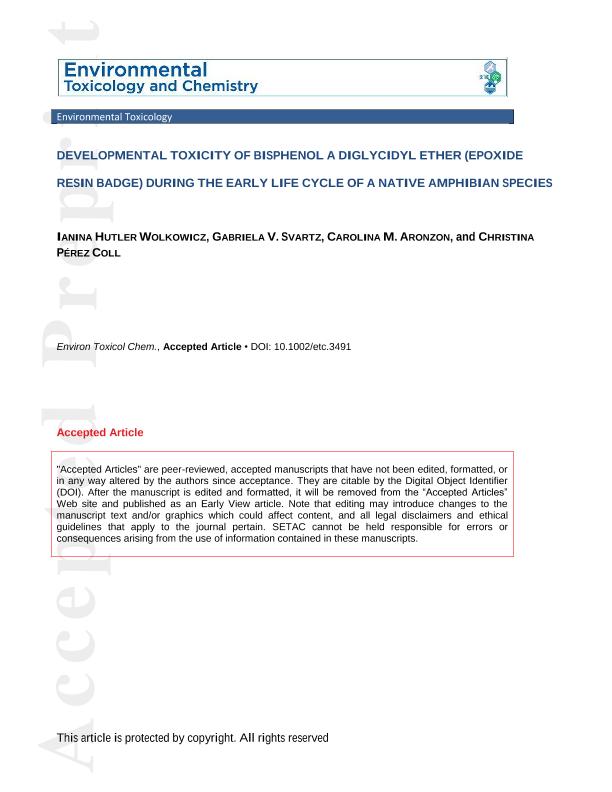Artículo
Developmental toxicity of bisphenol A diglycidyl ether (epoxide resin badge) during the early life cycle of a native amphibian species
Hutler Wolkowicz, Ianina Ruth ; Svartz, Gabriela Veronica
; Svartz, Gabriela Veronica ; Aronzon, Carolina Mariel
; Aronzon, Carolina Mariel ; Perez Coll, Cristina Silvia
; Perez Coll, Cristina Silvia
 ; Svartz, Gabriela Veronica
; Svartz, Gabriela Veronica ; Aronzon, Carolina Mariel
; Aronzon, Carolina Mariel ; Perez Coll, Cristina Silvia
; Perez Coll, Cristina Silvia
Fecha de publicación:
12/2016
Editorial:
Society of Environmental Toxicology and Chemistry
Revista:
Environmental Toxicology and Chemistry
ISSN:
0730-7268
Idioma:
Inglés
Tipo de recurso:
Artículo publicado
Clasificación temática:
Resumen
Bisphenol A diglycidyl ether (BADGE) is used in packaging materials, in epoxy adhesives, and as an additive for plastics, but it is also a potential industrial wastewater contaminant. The aim of the present study was to evaluate the adverse effects of BADGE on Rhinella arenarum by means of standardized bioassays at embryo–larval development. The results showed that BADGE was more toxic to embryos than to larvae at all exposure times. At acute exposure, lethality rates of embryos exposed to concentrations of 0.0005 mg/L BADGE and greater were significantly higher than rates in the vehicle control, whereas lethality rates of larvae were significantly higher in concentrations of 10 mg/L BADGE and greater. The toxicity then increased significantly, with 96‐h median lethal concentrations (LC50s) of 0.13 mg/L and 6.9 mg/L BADGE for embryos and larvae, respectively. By the end of the chronic period, the 336‐h LC50s were 0.04 mg/L and 2.2 mg/L BADGE for embryos and larvae, respectively. This differential sensitivity was also ascertained by the 24‐h pulse exposure experiments, in which embryos showed a stage‐dependent toxicity, with blastula being the most sensitive stage and S.23 the most resistant. The most important sublethal effects in embryos were cell dissociation and delayed development, whereas the main abnormalities observed in larvae related to neurotoxicity, as scare response to stimuli and narcotic effect.
Archivos asociados
Licencia
Identificadores
Colecciones
Articulos(SEDE CENTRAL)
Articulos de SEDE CENTRAL
Articulos de SEDE CENTRAL
Citación
Hutler Wolkowicz, Ianina Ruth; Svartz, Gabriela Veronica; Aronzon, Carolina Mariel; Perez Coll, Cristina Silvia; Developmental toxicity of bisphenol A diglycidyl ether (epoxide resin badge) during the early life cycle of a native amphibian species; Society of Environmental Toxicology and Chemistry; Environmental Toxicology and Chemistry; 35; 12; 12-2016; 3031-3038
Compartir
Altmétricas



